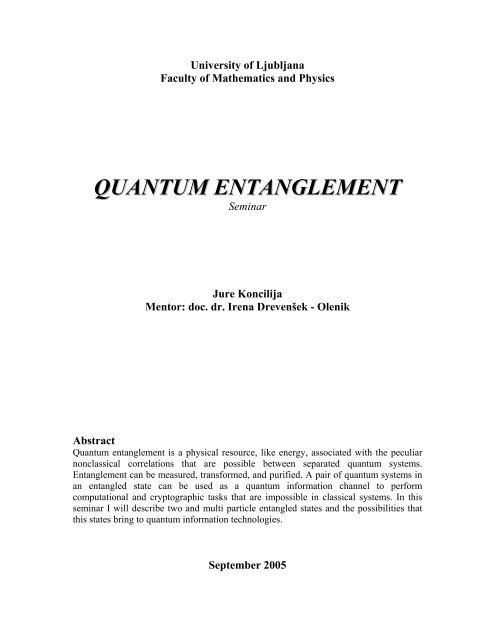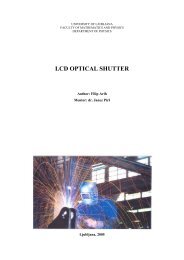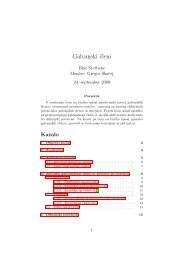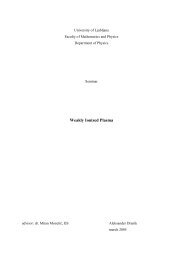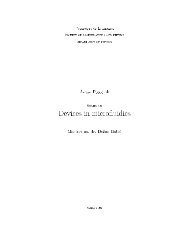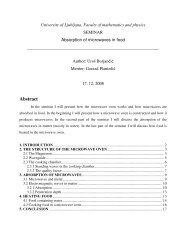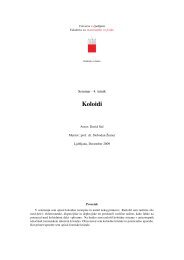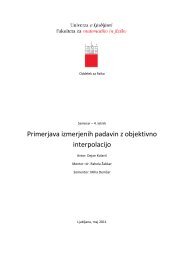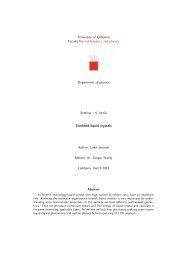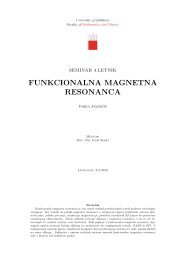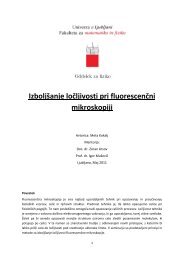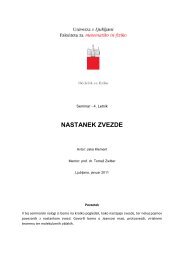quantum entanglement - Univerza v Ljubljani
quantum entanglement - Univerza v Ljubljani
quantum entanglement - Univerza v Ljubljani
You also want an ePaper? Increase the reach of your titles
YUMPU automatically turns print PDFs into web optimized ePapers that Google loves.
University of Ljubljana<br />
Faculty of Mathematics and Physics<br />
QUANTUM ENTANGLEMENT<br />
Seminar<br />
Jure Koncilija<br />
Mentor: doc. dr. Irena Drevenšek - Olenik<br />
Abstract<br />
Quantum <strong>entanglement</strong> is a physical resource, like energy, associated with the peculiar<br />
nonclassical correlations that are possible between separated <strong>quantum</strong> systems.<br />
Entanglement can be measured, transformed, and purified. A pair of <strong>quantum</strong> systems in<br />
an entangled state can be used as a <strong>quantum</strong> information channel to perform<br />
computational and cryptographic tasks that are impossible in classical systems. In this<br />
seminar I will describe two and multi particle entangled states and the possibilities that<br />
this states bring to <strong>quantum</strong> information technologies.<br />
September 2005
Contents<br />
1. Introduction 3<br />
2. Quantum information 4<br />
2.1. Quantum superposition 4<br />
2.2. Qubit 4<br />
2.3. Single-Qubit transformations 5<br />
2.4. Entanglement 6<br />
2.5. The EPR argument and Bell's inequality 7<br />
3. Quantum <strong>entanglement</strong> 9<br />
3.1. Entangled pair 9<br />
3.2. Producing <strong>quantum</strong> entangled states 9<br />
3.3. Generation of correlated photon pairs in type-II parametric down-conversion 10<br />
3.4. Multi photon <strong>entanglement</strong> 12<br />
4. Quantum dense coding 13<br />
4.1. Quantum dense coding protocol 13<br />
4.2. Experimental dense coding with qubits 14<br />
5. Conclusion 16<br />
6. References 17<br />
2
1. Introduction<br />
One hundred years ago Albert Einstein introduced the concept of the photon.<br />
Although in the early years after 1905 the evidence for <strong>quantum</strong> nature of light was not<br />
compelling, modern experiments, especially those using photon pairs, have beautifully<br />
confirmed its corpuscular character. Research on the <strong>quantum</strong> properties of light<br />
(<strong>quantum</strong> optics) triggered the evolution of the whole field of <strong>quantum</strong> information<br />
processing, which now promises new technology, such as <strong>quantum</strong> cryptography and<br />
even <strong>quantum</strong> computers [1].<br />
Although Einstein was one of the creators of <strong>quantum</strong> theory, he never liked all of<br />
its implications. In particular, he simply could not accept the idea that randomness should<br />
be an inherent principle of nature. He felt that the theory did not and could not explain<br />
why <strong>quantum</strong> effects should appear random to us. He revealed all his doubts in a paper<br />
written together with B. Podolsky and N. Rosen entitled "Can <strong>quantum</strong>-mechanical<br />
description of physics reality be considered complete?" In their paper, EPR argued that<br />
description of nature should obey the following two properties. First, anything that<br />
happens here and now can influence the result of a measurement elsewhere, but only if<br />
enough time has elapsed for a signal to get there without traveling faster than the speed of<br />
light. Second, the result of a measurement is predetermined, particularly if one can<br />
predict it with complete certainty (in other words a result is fixed even if we do not carry<br />
out the measurement itself). Afterwards they examined what impact would these two<br />
conditions have on observations of <strong>quantum</strong> particles that had previously interacted with<br />
one another. They concluded that such particles would exhibit correlations that lead to<br />
contradictions with Heisenberg's uncertainty principle.<br />
In the same year of 1935 Erwin Schrödinger published a response to the EPR<br />
paper, in which he introduced the notion of "<strong>entanglement</strong>" to describe such <strong>quantum</strong><br />
correlations. He said that <strong>entanglement</strong> was the essence of <strong>quantum</strong> mechanics and that it<br />
illustrated the difference between the <strong>quantum</strong> and classical worlds in the most<br />
pronounced way. Schrödinger realized that two entangled particles have to be seen as a<br />
whole, rather than as two separate entities. [2]<br />
After that the studies of <strong>entanglement</strong> paused for thirty years until John Bell's<br />
reconsideration and extension of the EPR argument [1]. Bell looked at <strong>entanglement</strong> in<br />
simpler systems, matching correlations between two-valued dynamical quantities, such as<br />
polarization or spin, of two separated systems in an entangled states. His investigation<br />
generated an ongoing debate on the foundations of <strong>quantum</strong> mechanics. One important<br />
feature of this debate was confirmation that <strong>entanglement</strong> can persist over long distances.<br />
[2] But it was yet in the 1980s that physicists, computer scientists and cryptographers<br />
began to regard the non-local correlations of entangled <strong>quantum</strong> states, which have<br />
become an important part of <strong>quantum</strong> information processing and <strong>quantum</strong> computations.<br />
Physicists nowadays are making great efforts to entangle as many particles as possible<br />
and in 2004 a group of scientist lead by Jian Wei Pan succeeded in entangling five<br />
photons [5]. Although four photons had been entangled before, this was a great<br />
breakthrough because five is the minimum number needed for universal error correction<br />
in <strong>quantum</strong> computation [4].<br />
3
2. Quantum information<br />
2.1. Quantum superposition<br />
The superposition principle plays the most central role in all considerations of<br />
<strong>quantum</strong> information. The essential experiment to describe the superposition is the<br />
double-slit experiment. It is composed of a source, a double-slit assembly, and an<br />
observation screen on which we observe the interference fringes. The interference fringes<br />
may easily be understood on the basis of assuming a wave property of the particles<br />
emerging from the source.<br />
Figure 1: The double slit experiment [3]<br />
Quantum mechanically, the state is the coherent superposition:<br />
1<br />
ψ = ( ψa + ψb<br />
) (1)<br />
2<br />
where ψ a and ψ b describe the <strong>quantum</strong> state with only slit a or slit b open. The<br />
interesting feature in <strong>quantum</strong> double-slit experiment is the observation that the<br />
interference pattern can be collected one by one (one particle interferes with itself), and<br />
that it is impossible of knowing which of the two slits a particle really takes in the<br />
experiment. Any kind of experiment determining this information (we would need to<br />
interact with the particle) would lead to decoherence - loss of interference.<br />
2.2. Qubit<br />
The most fundamental entity in information science is the bit. This is a system<br />
that carries two possible values: "0" and "1", which determine two distinguished states.<br />
No spontaneous transition can occur between the two states.<br />
The <strong>quantum</strong> analog of a bit, the qubit, therefore also has to be a two-state system<br />
where the two states are simply called 0 and 1 . Basically any <strong>quantum</strong> system that<br />
has at least two states can serve as a qubit 1 . The most essential property of <strong>quantum</strong><br />
1 A two-state <strong>quantum</strong> system, that can be used as a qubit is for example spin. We distinguish to opposite<br />
spin states: up ↑ and down ↓ .<br />
4
states, when used to encode bits, is the possibility of coherence and superposition, the<br />
general state being:<br />
Q = α 0 + β 1<br />
(2)<br />
with<br />
probability<br />
2 2<br />
α + β = 1.<br />
This means that if we measure the qubit, we will find it with<br />
2<br />
2<br />
α to carry the value "0" and with probability β to carry the value "1". It<br />
is important to know that eq. (2) describes a coherent superposition rather than incoherent<br />
mixture between "0" and "1". For a coherent superposition there is always a basis in<br />
which the value of the qubit is well defined (as shown in further example), while for an<br />
incoherent mixture it is a mixture whatever way we choose to describe it. Let us consider<br />
a specific state<br />
1<br />
Q′ = ( 0 + 1 ) (3)<br />
2<br />
This clearly means that with 50% probability the qubit will be found to be rather "0" or<br />
"1". Interestingly in basis rotated for 45 in Hilbert space the value of the qubit is well<br />
defined. One of the most basic transformations in <strong>quantum</strong> information science is<br />
Hadamard transformation ( ):<br />
°<br />
ˆH<br />
ˆ 1 ˆ 1<br />
H 0 0 1 , H 1 0<br />
2 2<br />
→ ( + ) → ( − )<br />
1 (4)<br />
Applying this to the qubit Q′ above, results in ˆ HQ′ = 0 , a well defined state, which<br />
is never possible with an incoherent mixture.<br />
2.3. Single-Qubit transformations<br />
Insight of some basic experimental procedures in <strong>quantum</strong> information physics<br />
can be gained by investigating the action of a simple 50/50 beamsplitter. Let us<br />
investigate the case of just two incoming modes and two outgoing modes.<br />
Figure 2: The 50/50 beamsplitter [3]<br />
The effect of such a BS (beamsplitter) on an ingoing - incident state Q = 0 is the<br />
in in<br />
final state Q = 1<br />
2 ( 0 + 1 ), and on an ingoing state Q = 1 the final state is<br />
out<br />
in in<br />
5
(<br />
Q = 1 0 − 1<br />
2 ). For a 50/50 BS, a particle incident either from above or from<br />
out<br />
below has the same probability of 50% of emerging in either output beam, above or<br />
below. The beamsplitter is non-absorbing. A very simple way to describe the action of a<br />
beamsplitter is by the Hadamard transformation eq. (4). The incident state is in general<br />
Q = α 0 + β 1 . Then the action of the beamsplitter results in the final state:<br />
in in in<br />
1<br />
Q = Hˆ Q = ( ( α + β) 0 + ( α − β)<br />
1<br />
out in out out ) (5)<br />
2<br />
where ( α + β ) is now the probability amplitude for finding the particle in the outgoing<br />
upper beam and (α − β ) is the probability amplitude for finding it in the lower beam. It is<br />
interesting and instructive to consider sequences of such beamsplitters because they<br />
realize sequences of Hadamard transformations. The double application of Hadamard<br />
Q = Hˆ Hˆ Q = Q .<br />
transformation is the identity operation ( )<br />
out in in<br />
Another important <strong>quantum</strong> gate besides the Hadamard gate is the phase shifter,<br />
which is introduced into the double beamslitter sequence:<br />
Figure 3: Double beamslitter sequence including a phase shifter in one of the two beams [3]<br />
Its operation is simply to introduce a phase change ϕ to the amplitude of one of the two<br />
beams. The action can be described as: Φ ˆ i<br />
0 = e 0 , Φ ˆ 1 = 1 . The output qubit can be<br />
ϕ<br />
calculated as: Q = HˆΦ ˆ Hˆ Q . For example let us take the input qubit ( α = 1, β = 0 )<br />
out in<br />
Q = 0 . The final state becomes:<br />
in<br />
ˆ ˆ ˆ 1 iϕ iϕ<br />
HΦ H 0 = ( ( e + 1) 0 + ( e − 1) 1 ) (6)<br />
2<br />
This means that the phase shift is able to switch the output qubit between "0" and "1".<br />
For instatnce, if one arranges ϕ = π then the state 0 is transferred to in ( − 1 out ) .<br />
2.4. Entanglement<br />
Let us consider a source which emits a pair of particles such that one particle<br />
emerges to the left and the other to the right . The source is such that the particles are<br />
emitted with opposite momenta.<br />
6
Figure 4: A two particle interferometer verification:<br />
source S emits two qubits in an entangled state [3]<br />
If the particle emerging to the left, which we call particle 1, is found in the upper beam,<br />
then the particle 2 traveling to the right is always found in the lower beam and vice versa.<br />
In qubit language we would say that the two particles carry different bit values. Quantum<br />
1 i<br />
0 1 e 1 0<br />
2 χ<br />
+ .<br />
mechanically this is a two-particle superposition state of the form ( )<br />
The phase χ is determined by the internal properties of the source and we assume for<br />
simplicity 0<br />
χ = . The entangled state is therefore described as:<br />
1<br />
Φ = ( 0 1 + 1 0 ) (7)<br />
2<br />
Interesting property is that neither of the two qubits carries a definite value, but what is<br />
known from <strong>quantum</strong> state is that as soon as one of the two qubits is subject to a<br />
measurement, the result of this measurement being completely random, the other one will<br />
immediately be found to carry the opposite value. This phenomenon represents the<br />
<strong>quantum</strong> non-locality, since the two qubits could be separated by arbitrary distances at<br />
the time of the measurement.<br />
2.5. The EPR argument and Bell's inequality<br />
Immediately after the discovery of modern <strong>quantum</strong> mechanics, it was realized<br />
that it contains novel, counterintuitive features. While Einstein initially tried to argue that<br />
<strong>quantum</strong> mechanics is inconsistent, he later reformulated his argument towards<br />
demonstrating that <strong>quantum</strong> mechanics is incomplete. In the seminal paper, EPR consider<br />
<strong>quantum</strong> systems consisting of two particles such that, while neither position nor<br />
momentum of either particle is well defined, the sum of their positions (that is the centre<br />
of mass) and the difference of their momenta (that is their individual momenta in the<br />
centre of mass system) are both precisely defined. It then follows that a measurement of<br />
either position or momentum performed on, say, particle 1 immediately implies a precise<br />
position or momentum, respectively, for particle 2, without interacting with that particle.<br />
Assuming that the two particles can be separated by arbitrary distances, EPR suggests<br />
that a measurement on particle 1 cannot have any actual influence on particle 2 (locality<br />
condition); thus the property of particle 2 must be independent of the measurement<br />
performed on particle 1. It follows that both position and momentum can simultaneously<br />
be well defined properties of a <strong>quantum</strong> system [3].<br />
7
In 1951 David Bohm introduced spin-entangled systems and in 1964 John Bell<br />
showed that, for such entangled systems, measurements of correlated quantities should<br />
yield different results in the <strong>quantum</strong> mechanical case to those expected if one assumes<br />
that the properties of the system measured prior to, and independent of, the observation.<br />
Let us briefly present the line of reasoning that leads to an inequality equivalent to<br />
the original Bell inequality. Consider a source emitting two qubits in the polarisation<br />
entangled state eq. (7). Such a state can be obtained from a decaying atom of cesium,<br />
which emits two photons in opposite directions. The photons are circularly polarised one<br />
right and the other left. The emitting process therefore conserves both the momentum and<br />
the angular momentum of the cesium atom.<br />
Figure 5: Correlation measurement experiment [3]<br />
One qubit is sent to Alice (to the left in Fig. 5), the other is sent to Bob (to the right). On<br />
both sides the polarisation measurements are made using polarising beamsplitter with two<br />
single-photon detectors in the output ports. Alice will obtain the measurement result "0"<br />
or "1", corresponding to the detection of a qubit by detector D1 or D2 respectively, each<br />
with equal probability. This statement is valid in whatever polarisation basis she decides<br />
to perform the measurement, the actual results being completely random. Yet, if Bob<br />
chooses the same basis as Alice, he will always obtain the same result as Alice.<br />
Following the first step of EPR reasoning, Alice can predict with certainty, what Bob's<br />
result will be. The second step employs the locality hypothesis - the assumption that no<br />
physical influence can instantly go from Alice's apparatus to Bob's, therefore his<br />
measured result should only depend on the properties of his qubit and on the apparatus he<br />
chose. Combining the two steps, J. Bell investigated possible correlations for the case that<br />
Alice and Bob choose detection bases which are at oblique angles. For three arbitrary<br />
angular orientations α, βγ , (used by Alice and Bob in different combinations) the<br />
following inequality must be fulfilled:<br />
N(1 ,1 ) ≤ N(1 ,1 ) + N(1<br />
, 0 )<br />
(8)<br />
α β α γ β γ<br />
N0<br />
2<br />
where N(1 α,1 β) = cos ( α − β )<br />
2<br />
2 is the <strong>quantum</strong>-mechanical prediction for the number<br />
of cases where Alice obtains "1" with her apparatus at orientation α and Bob achieves<br />
"1" with orientation β and N0<br />
is the number of pairs emitted by the source. The<br />
inequality is violated by the <strong>quantum</strong>-mechanical prediction if we choose, for example<br />
2 The first value in the brackets always belongs to Alice's measurement and the second to Bob's<br />
measurement.<br />
8
( α − β) = ( β − γ)<br />
= 30<br />
. The violation implies that at least one of the assumptions<br />
entering Bell's inequality must be in conflict with Quantum mechanics. This is usually<br />
viewed as evidence for non-locality [3].<br />
3. Quantum <strong>entanglement</strong><br />
3.1. Entangled pair<br />
Quantum <strong>entanglement</strong> is a physical resource, like energy, associated with the<br />
peculiar nonclassical correlations that are possible between separated <strong>quantum</strong> systems.<br />
Entanglement can be defined on any two-valued dynamical quantity that a par of particles<br />
posses. The most common is the <strong>entanglement</strong> on the level of spin or polarization. There<br />
are many natural sources of entangled pairs. A very simple example is a pion which has<br />
no spin. When the pion decays it splits into two photons that shoot away in opposite<br />
directions. These two photons have spin. If we measure the spin value of one photon we<br />
instantaneously know the spin value of the other because their spin has to add up into no<br />
spin - that pion has in the first place. Such pairs of photons or other particles are called<br />
entangled pairs.<br />
3.2. Producing <strong>quantum</strong> entangled states<br />
In order to understand both the nature of <strong>entanglement</strong> and ways of producing it,<br />
one has to realize that in states of form eq. (7) we have a superposition between product<br />
states. As we know, superposition means that there is no way to tell which of the two<br />
possibilities forming the superposition actually pertains. This rule must also be applied to<br />
1<br />
Ψ = 0 1 + 1 0<br />
the understanding of <strong>quantum</strong> <strong>entanglement</strong>. In the state ( )<br />
2<br />
12 1 2 1 2<br />
there is no way of telling whether qubit 1 carries the value "0" or "1" and likewise<br />
whether qubit 2 carries value "0" or "1". Yet, if one qubit is measured the other one<br />
immediately assumes a well-defined <strong>quantum</strong> state.<br />
To produce entangled <strong>quantum</strong> states, one has various possibilities. First, one can<br />
create a source which, through its physical construction, is such that the <strong>quantum</strong> states<br />
emerging already have the indistinguishibility feature discussed above. This is realized,<br />
for example, by the decay of a spin-0 particle into two spin- 1 2 particles under<br />
conservation of the internal angular momentum. In this case, thee two spins of the<br />
emerging particles have to be opposite and, if no further mechanism exist which permits<br />
us to distinguish the possibilities right at the source, the emerging <strong>quantum</strong> state is:<br />
where<br />
( )<br />
1<br />
Ψ = ↑ ↓ − ↓ ↑ (9)<br />
12 1 2 1 2<br />
2<br />
↑ means particle 1 with spin up. This state has the remarkable property that it is<br />
1<br />
rotationally invariant: the two spins are anti-parallel along whichever direction we choose<br />
to measure.<br />
9
A second possibility is that a source might actually produce <strong>quantum</strong> states of the<br />
1<br />
form of the individual components in the superposition Ψ = 12 ( 0 1 + 1 0<br />
1 2 1 2 ) .<br />
2<br />
But the states might still be distinguished in some way. This happens, for example, in<br />
type-II parametric down-conversion 3 (see reference [9] for detailed description), where<br />
along a certain chosen direction the two emerging photon states are H V and<br />
1 2<br />
V H . That means that either photon 1 is horizontally polarized and photon 2 is<br />
1 2<br />
vertically polarized, or vice versa. Because of the different speeds of light for the H and<br />
V polarized photon inside down-conversion crystal, the time correlation between the two<br />
photons is different in the two cases. However the entaglement can be produced by<br />
shifting the two photon-wave packets after their production relative to each other such<br />
that they become indistinguishable on the basis of their position in time. The entangled<br />
state for this case can be written as:<br />
1<br />
iϕ<br />
Ψ = 12 ( H V + e V H<br />
1 2 1 2 ) (10)<br />
2<br />
A third means of producing entangled states is to project a non-entangled state<br />
onto an entangled one. Consider a source producing the non-entangled state 0 1 . 1 2<br />
Suppose this state is now sent through filter described by the projection operator<br />
P =Ψ 12 Ψ , where 12 Ψ is in the state of eq. (7):<br />
12<br />
( 0 1 )<br />
P =<br />
1 2<br />
1<br />
= ( 0<br />
2<br />
1 + 1 0 )( 0 1 + 1 0 ) 0 1<br />
1<br />
= ( 0 1 2<br />
1 + 1 2 1 0 2)<br />
1 2 1 2 1 2 1 2 1 2<br />
The state is no longer normalized to unity because the projection procedure implies a loss<br />
of qubits.<br />
3.3. Generation of correlated photon pairs in type-II parametric downconversion<br />
Most commonly used way to produce entangled pairs is parametric down<br />
conversion. The basic optical configuration used for this process is shown in Fig. 6.<br />
3<br />
type-II parametric down-conversion: a nonlinear crystal splits incoming photons into pairs of photons<br />
of lower energy whose combined energy<br />
and momentum is equal to the energy and momentum of the<br />
original photon: k = k + k<br />
<br />
ω = ω + ω . "Parametric" refers to the fact that the state of the<br />
ω ω<br />
in<br />
1<br />
ω and<br />
2 in 1 2<br />
crystal is left unchanged in the process, which is why energy and momentum are conserved. Type-II means<br />
that the phase-matching condition is noncolinear.<br />
=<br />
(11)<br />
10
Figure 6: left: geometrical arrangement for type-II parametric down-conversion [9]<br />
right: the two rings of type-II down-conversion as seen through a narrow-band filter[3]<br />
A pump beam enters a nonlinear optical crystal as an extraordinary beam, and is partially<br />
converted into pairs of photons, obeying energy and momentum conservation. The two<br />
photons in a pair created in this process using the type-II phase-matching condition are<br />
always orthogonally polarised [9]. At certain angles between the pump-beam and the<br />
optical axis of the conversion crystal the phase-matching conditions will be such that the<br />
photons are emitted along cones, which do not have common axis (as illustrated in fig. 6)<br />
One of the cones is ordinarily polarised (idler) and the other extraordinarily (signal). This<br />
cones will in generally intersect along two directions where the emitted light is<br />
unpolarised, because we cannot distinguish whether a certain photon belongs to one or<br />
the other cone. Yet this is not exactly true, because in the crystal the e-polarised and opolarised<br />
photons will propagate with different velocities, so in principle we can<br />
distinguish the two cases by the order of their detection times. It is however possible to<br />
compensate for that "walkoff", by inserting identical crystals of half the thickness rotated<br />
by 90 in each of the two beams. This procedure completely erases any velocity and<br />
arrival time differences and we have a true polarisation-entangled state which can be<br />
described by eq.(10). Further more we can use these compensator crystals to change the<br />
phase<br />
<br />
χ between the two components of the entangled state. If we use an additional halfwave<br />
plate in one of the two beams we can also produce states:<br />
± 1<br />
Φ = ( V V ± H H<br />
12<br />
1 2 1 2)<br />
(12)<br />
2<br />
11
Now we have become acquainted with all four maximally entangled two-qubit<br />
states or Bell states:<br />
± 1<br />
Φ = ( x x ± y y<br />
1 2 1 2)<br />
12 2<br />
(13)<br />
± 1<br />
Ψ = ( x y ± y x<br />
1 2 1 2)<br />
12 2<br />
This is a general expression, where x and y represent qubit values. For spin <strong>entanglement</strong><br />
the values of x and y are written as ↑ and ↓ and for polarisation <strong>entanglement</strong> as H and<br />
V.<br />
3.4. Multi photon <strong>entanglement</strong><br />
The method to entangle more than two photons was suggested by a group of<br />
scientists Greenberger-Horne-Zeilinger and is therefore called GHZ <strong>entanglement</strong>. We<br />
start by two polarization-entangled photon pairs (1-2 and 3-4) which are in the first Bell<br />
+<br />
state Φ :<br />
+<br />
Φ =<br />
12<br />
1<br />
2<br />
+<br />
+<br />
Φ =<br />
34<br />
1<br />
2<br />
+<br />
( H H V V )<br />
1 2 1 2<br />
( H H V V )<br />
3 4 3 4<br />
where H denotes horizontal polarization and V vertical. One photon out of each pair<br />
(photon 2 and photon 3) is then steered to a polarizing beam-splitter (PBS) 4 as shown on<br />
figure 7:<br />
Figure 7: The scheme of the GHZ <strong>entanglement</strong> method for four photons<br />
The path lengths of each photon have to be adjusted such that they arrive simultaneously<br />
on the splitter. Because the PBS transmits H and reflects V polarization, coincidence<br />
detection between the two outputs of PBS, implies that either both photons, 2 and 3, are<br />
H polarized or both V polarized. After PBS the renormalized state corresponding to a<br />
fourfold coincidence is:<br />
4 A polarising beam-splitter is an optical element composed of two prisms, that reflect horizontal<br />
polarization and transmit vertical polarization of the incoming light beam.<br />
(14)<br />
12
1<br />
Φ = 1234 ( H H H H + V V V V<br />
1 2 3 4 1 2 3 4 )<br />
(15)<br />
2<br />
which exhibits four-photon GHZ <strong>entanglement</strong>.<br />
To generate five-photon <strong>entanglement</strong> (five is the highest number of entangled<br />
photons achieved to this day) we further prepare one more photon in the state<br />
1<br />
( H V 1<br />
2 + 1 ) from a single photon source. The scheme of the experiment is shown on<br />
figure 8:<br />
Figure 8: The scheme of the GHZ <strong>entanglement</strong> method for five photons [5]<br />
As shown on figure 2, two PBS are needed: PBS12 to entangle photon 1 from the single<br />
photon source with photon 2 of the entangled pair 23, and PBS34 to entangle photon 3<br />
from the first pair and photon 4 from the second pair of entagled photons. The path<br />
lengths of the photons 1,2,3 and 4 must be carefully adjusted such that they arrive<br />
simultaneously at the designated PBS. After the photons pass through the two PBS, the<br />
state corresponding to a fivefold coincidence is given by:<br />
1<br />
Φ = 12345 ( H H H H H + V V V V V<br />
1 2 3 4 5 1 2 3 4 5 ) (16)<br />
2<br />
This is exactly a five-photon GHZ state.<br />
Multiphoton <strong>entanglement</strong> is needed to realizing <strong>quantum</strong> computations, <strong>quantum</strong><br />
teleportation and building <strong>quantum</strong> computers.<br />
4. Quantum dense coding<br />
4.1. Quantum dense coding protocol<br />
The scheme for <strong>quantum</strong> dense coding utilises <strong>entanglement</strong> between two qubits,<br />
each of which individually has two orthogonal states 0 and 1 . Quantum mechanics<br />
allows one to encode information superpositions of states of two or more entangled<br />
particles. The most convenient basis in which to represent such states is formed by<br />
maximally entangled Bell states - eq.13. Identifying each Bell state with different<br />
13
information we can encode two bits of information by manipulating only one of the two<br />
particles.<br />
This is achieved in the following <strong>quantum</strong> communication scheme. Initially, Alice<br />
+<br />
and Bob each obtain one particle of an entangled pair, let us say, in the state of Ψ<br />
given in eq. 13. Bob then performs one out of four possible unitary transformations on his<br />
particle alone. The four such transformations are:<br />
1. Identity operation (not changing the original two-particle state<br />
+<br />
Ψ )<br />
12<br />
2. State change ( 0 → 1 and 1 → 0 ; changing the two-particle state to<br />
2 2<br />
2 2<br />
3. State-dependent phase shift (differing by π for 0 and 1 ; transforming to<br />
2<br />
2<br />
4. State change and phase shift together (giving the state<br />
−<br />
Φ )<br />
12<br />
+<br />
Φ )<br />
12<br />
12<br />
−<br />
Ψ )<br />
12<br />
Since the four manipulations result in the four orthogonal Bell states, four distinguishable<br />
messages, 2 bits of information, can be sent via Bob's two state particle to Alice, who<br />
finally reads the encoded information (see fig.9) by determining the Bell state of the two<br />
particle system.<br />
4.2. Experimental dense coding with qubits<br />
A <strong>quantum</strong>-optical demonstration [3] of the <strong>quantum</strong> dense coding scheme<br />
described in previous section requires three distinct parts; EPR source, Bob's station of<br />
encoding the messages by a unitary transformation of his particle and Alice's Bell-state<br />
analyser to read the signal sent to Bob (fig.9). The polarisation entangled photons (EPR<br />
source) can be produced by type-II parametric down-conversion.<br />
Figure 9: Experimental setup for <strong>quantum</strong> dense coding [3].<br />
14
One particle of entangled state<br />
+<br />
Ψ is directed to Bob's encoding station, the<br />
other directly to Alice's analyser.<br />
For polarisation encoding, the necessary transformation of Bob's particle is<br />
performed using a half-wave retardation plate for changing the polarisation and a quarterwave<br />
plate to generate the polarisation dependent phase shift. The beam manipulated in<br />
this way then combined with the other beam at Alice's Bell-state analyser. It consisted of<br />
a single 50/50 beamsplitter followed by two-channel PBS polarisators in each of its<br />
outputs and a proper coincidence analysis between four single photon detectors.<br />
−<br />
Since only the state Ψ has an antisymmetric spatial part, only this state will be<br />
registered by coincidence detection between the different outputs of the beamsplitter<br />
(coincidence between H D and V D ′ , or between H D ′ and DV<br />
). For the remaining three<br />
states both photons exit into the same output port of the beamsplitter. The state<br />
+<br />
Ψ can<br />
easily be distinguished from the other two due to the different polarisations of the two<br />
photons, giving behind the two channel polariser a coincidence between detectors H D<br />
and DV or H D ′ and D V ′ . The two states<br />
−<br />
Φ and<br />
+<br />
Φ cannot be distinguished. The<br />
following table gives an overview of the different manipulations and detection<br />
probabilities of Bob's encoder and Alice's receiver.<br />
Bob's setting<br />
λ λ<br />
2 4<br />
0 0 <br />
0 90 <br />
45 0 <br />
45 90 <br />
State sent Alice's registration events<br />
+<br />
Ψ<br />
−<br />
Ψ<br />
+<br />
Φ<br />
−<br />
Φ<br />
coinc. between D H and DV or H D ′ and V D ′<br />
coinc. between H D and V D ′ or H D ′ and<br />
2 photons in either D H , DV , H D ′ or<br />
2 photons in either D H , DV , H D ′ or<br />
To characterize the interference observable at Alice's Bell-state analyser, the path length<br />
difference ∆ of the two beams is varied with the optical trombone. For ∆ c no<br />
interference occurs and one obtains classical statistics for coincidence count rates at the<br />
detectors. For optimal path length tunning (<br />
l <br />
∆ = 0 ), interference enables one to read the<br />
encoded information.<br />
D V ′<br />
D V ′<br />
DV<br />
15
(a) (b)<br />
Figure 10: coincidental rates C HV ( • ) and C HV ′ ( ) as function of the path length difference ∆ [3] for<br />
two different Bell states: (a)<br />
+<br />
Ψ and (b)<br />
5. Conclusion<br />
Entanglement breaks new record in June 2004, when physicists succeeded in<br />
entangling five photons for the first time. This was a key step, which makes it possible to<br />
check computations for errors and teleport <strong>quantum</strong> information within and between<br />
computers. With the GHZ method of multiparticle <strong>entanglement</strong>, the doors are open to<br />
entangle as many particles wanted, which announces the progress of <strong>quantum</strong> computers.<br />
By taking advantage of <strong>quantum</strong> phenomena such as <strong>entanglement</strong>, teleportation (a<br />
process where a certain <strong>quantum</strong> state of a single particle is transferred from Alice to<br />
Bob, without actually delivering the particle itself) and superposition, a <strong>quantum</strong><br />
computer could, in principle, outperform a classical computer in certain computational<br />
tasks (For example, a system of 500 qubits, which is impossible to simulate classically,<br />
represents a <strong>quantum</strong> superposition of as many as 2 500 states. Each state would be<br />
classically equivalent to a single list of 500 1's and 0's. Any <strong>quantum</strong> operation on that<br />
system - a particular pulse of radio waves, for instance, whose action might be to execute<br />
a controlled NOT operation on the 100th and 101st qubits - would simultaneously operate<br />
on all 2 500 states. Hence with one fell swoop, one tick of the computer clock, a <strong>quantum</strong><br />
operation could compute not just on one machine state, as serial computers do, but on<br />
2 500 machine states at once!) [4], [8].<br />
New discoveries regarding <strong>quantum</strong> <strong>entanglement</strong> could revolutionize long<br />
distance communication.<br />
−<br />
Ψ<br />
16
6. References<br />
[1] A. Zeilinger, G. Weihs, T. Jennewein, M. Aspelmeyer, "Happy centenary, photon",<br />
Nature, Vol. 433, pp. 230-238, 2005<br />
[2] H. Weinfurther, "The power of <strong>entanglement</strong>", Physics World, January 2005<br />
[3] D. Boukwmeester, A. Ekert, A. Zeilinger, The Physics of Quantum Information,<br />
Springer-Verlag Berlin Heidelberg, 2000<br />
[4] http://physicsweb.org/articles/news/8/6/18/1<br />
[5] Z. Zhao et al., "Experimental demonstration of five-photon <strong>entanglement</strong> and<br />
open-destination teleportation", Nature, Vol. 430, pp. 54-58, 2004<br />
[6] http://beige.ovpit.indiana.edu/B679/node70.html<br />
[7] C. Kurtsiefer, M. Oberparleiter, H. Weinfurter," Generation of correlated photon<br />
pairs in type-II parametric down-conversion", Journal of modern optics, February 7,<br />
2001<br />
[8] http://www.cs.caltech.edu/~westside/<strong>quantum</strong>-intro.html<br />
[9] R.W. Boyd, Nonlinear optics, Academic press, 1992, pp. 85 -90<br />
17


